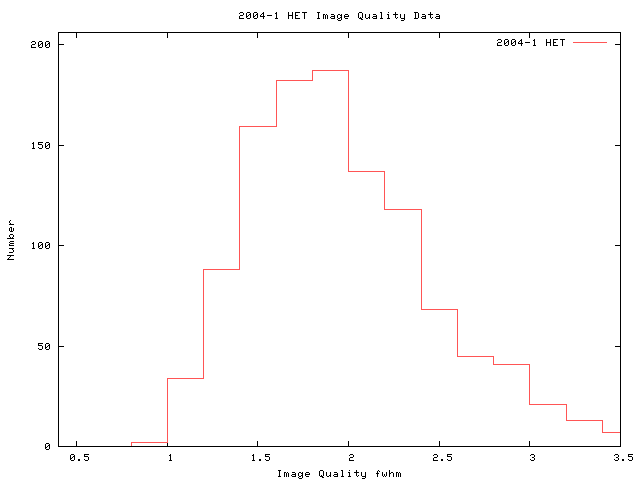
In this section we will discuss the status of each instrument and any limitation to configurations that occurred during the period.
NOTE: We are now using FWHM which is measured off both the LRS "pre" images and the FIF bent prime guider.
Here is a histogram from the last period.

For comparison here is the image quality for the period last year.
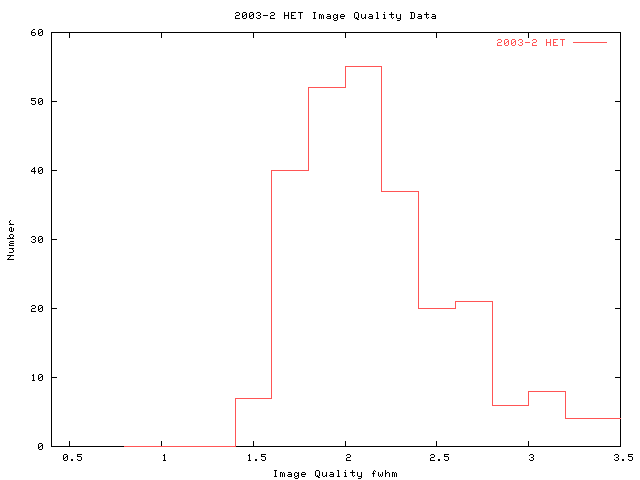
We expect to do a few tenths better than last year; about as good as the previous period.
We expect to have a similar overhead to last period. The following overhead statistics include slew, setup, readout and refocus between exposures (if there are multiple exposures per visit). In the summary page for each program the average setup time is calculated. The table below gives the average setup time for each instrument PER VISIT and the average and maximum PROPOSED science exposures and visit lengths.
| Instrument | Avg Overhead per Actual Visit(min) | Avg Overhead per Requested Visit(min) | Median Overhead per Requested Visit(min) | Avg Exposure (sec) | Median Exposure (sec) | Max Exposure (sec) | Avg Visit (sec) | Median Visit (sec) | Max Visit (sec) |
|---|---|---|---|---|---|---|---|---|---|
| LRS | 12.8 | 18.4 (from last period) | 18.9 (from last period) | 616.5 | 600 | 1800 | 1021.3 | 600 | 5400 |
| HRS | 10.4 | 11.5 (from last period) | 10.9 (from last period) | 612.8 | 660 | 2700 | 724.6 | 811 | 3600 |
| MRS | 9.0 | 18.0 (from last period) | 18.0 (from last period) | 964 | 900 | 1500 | 1077.0 | 1200 | 2100 |
NOTE: AS OF 2003-3 THE SETUP TIME FOR AN ATTEMPTED MRS OR HRS TARGET IS CAPPED AT 15 MINUTES.
NOTE: STARTING IN 2004-2 THE SETUP TIME FOR AN ATTEMPTED LRS TARGET WILL CAPPED AT SOME VALUE NOT YET SPECIFIED.
The overhead statistics can be shortened by multiple setups (each one counted as a separate visit) while on the same target as is the case for planet search programs. The overhead statistics can be lengthened by having multiple tracks that add up to a single htopx visit as can happen for very long tracks where each attempt might only yield a half visit.
A way to improve the overhead accumulated for programs with long exposure times is to add double the above overhead to the requested visit length and make sure that time is shorter than the actual track length. This avoids the RA having to split requested visits between several different tracks.
The following links give the summary for each institution and its programs.
The resulting table will give (for each program) the total number of targets
in the queue and the number completed, the CCD shutter open
hours, average overhead for that program, and the TAC allocated time.
This usually will be the best
metric for judging completeness but there are times when a PI will tell
us that a target is "done" before the total number of visits is complete.
This is how each institution has allocated its time by priority.
Observing Programs Status
Program comments:
UT04-2-001: (Shetrone) priority 2-3 HRS
UT04-2-002: (Prieto) HRS twilight program
UT04-2-003: (Prieto) priority 3-4 HRS
UT04-2-006: (Benedict) priority 1 HRS
UT04-2-007: (Cochran) priority 1-4 HRS
UT04-2-008: (Quimby) priority 0 LRS ToO
UT04-2-009: (Marion) priority 0 LRS ToO
UT04-2-010: (Gerardy) priority 0-2 LRS ToO
UT04-2-011: (Gerardy) priority 2 LRS ToO
UT04-2-012: (Endl) priority 1,3,4 HRS
UT04-2-013: (Hill) priority 2 LRS g1
UT04-2-014: (Hill) priority 0,2 LRS g1
UT04-2-015: (Kilic) priority 1-2 LRS g2
UT04-2-016: (Baliber) priority 0 HRS HRS ToO
UT04-2-017: (Gebhardt) priority 1 LRS g2
Program comments:
PSU04-2-001: (Wolszczan) priority 2,4 HRS
PSU04-2-002: (Wolszczan) priority 1,2,4 HRS
PSU04-2-003: (Gronwall) priority 4 LRS g2
PSU04-2-004: No Phase II received (Schneider) priority 1-4
PSU04-2-005: No Phase II received (Schneider) priority 1-4
PSU04-2-006: (VandenBerk) priority 1-3 LRS g1
PSU04-2-007: (Ge) priority 1-4 HRS
PSU04-2-008: (Ge) priority 1,4 LRS g1
PSU04-2-009: (Ge) priority 4 HRS
PSU04-2-010: (Debes) priority 3 HRS
PSU04-2-011: (Eracleous) priority 0 LRS ToO
PSU04-2-012: (Eracleous) priority 1-2 LRS g3
PSU04-2-013: (Ciardullo) priority 1-3 MRS
PSU04-2-014: (Ciardullo) priority 1-3 MRS
PSU04-2-015: (Stark) priority 3-4 HRS,MRS
PSU04-2-016: (Stark) priority 4 MRS
PSU04-2-017: (Brandt) priority 1-2 LRS g2
PSU04-2-018: (Brandt) priority 1 MRS
PSU04-2-019: (Brandt) priority 3 LRS R
Program comments:
STA04-2-001: (Romani/Michelson) priority 1,2,4 LRS g1
Program comments:
No programs submitted.
Program comments:
G04-2-001: (Kollatschny) priority 1 LRS g2 everyday
G04-2-002: (Dreizler) priority 2 LRS g2
G04-2-003: (Lembeck) priority 2 LRS g2
G04-2-004: (Dreizler) priority 3 HRS
Institution Status
| Time Allocation by Institution (hours) | |||||
|---|---|---|---|---|---|
| Institution | Priority 0 | Priority 1 | Priority 2 | Priority 3 | Priority 4 |
| PSU | 6.000 (3%) | 28.670 (16%) | 31.830 (17%) | 26.450 (14%) | 91.200 (50%) |
| UT | 15.500 (8%) | 33.000 (17%) | 54.000 (27%) | 47.000 (24%) | 50.000 (25%) |
| Stanford | 0.000 | 5.330 (22%) | 10.000 (42%) | 0.000 (0%) | 8.660(36%) |
| Munich | 0.000 (0%) | 0.000 (0%) | 0.000 (0%) | 0.000 (0%) | 0.000 (0%) |
| Goetting | 0.000 (0%) | 10.000 (50%) | 5.870 (30%) | 4.000 (20%) | 0.000 (0%) |
| NOAO | 0.000 | 14.000 (25%) | 4.000 (7%) | 38.000(68%) | 0.000 |
| SALT | 0.000 | 0.000 | 0.000 | 0.000 | 0.000 |
| DDT | 0.000 | 0.000 | 0.000 | 0.000 | 0.000 |
| UT04-1 | ||
|---|---|---|
| Rank | Program | Constraints |
| 1 | UT03-3-007 HD37605 | HRS, EE50 < 2.5, Vsky > 18.0 in twilight now |
| 2 | UT03-3-014 RAJAR4467 targets | LRS, EE50 < 1.7, Vsky > 20.0 |
| 1 | UT04-1-006 many MMJ targets | HRS, EE50 < 3.0, Vsky > 19.0 |
| PSU04-1 | ||
|---|---|---|
| Rank | Program | Constraints |
| 1 | PSU04-1-006 0845+0327,0757+3622 | LRS G1, EE50 < 2, Vsky > 20.0 |
| 2 | PSU04-1-012 B2_0742+31 | LRS G1 EE50 < 2.0, Vsky > 20.6 |
| 3 | PSU04-2-017 S50836+71,SBS1233+594 | LRS synoptic, EE50 < 5.0, Vsky > 20.2 |
| STA04-1 | ||
|---|---|---|
| Rank | Program | Constraints |
| 1 | STA04-1-001 J1015+6728 | LRS EE50 < 2.0, Vsky > 20.0 |
| M04-1 | ||
|---|---|---|
| Rank | Program | Constraints |
| G04-1 | ||
|---|---|---|
| Rank | Program | Constraints |
| 1 | G04-1-001 NGC4593 | LRS EE50 < 4.0, Vsky > 18.0 |
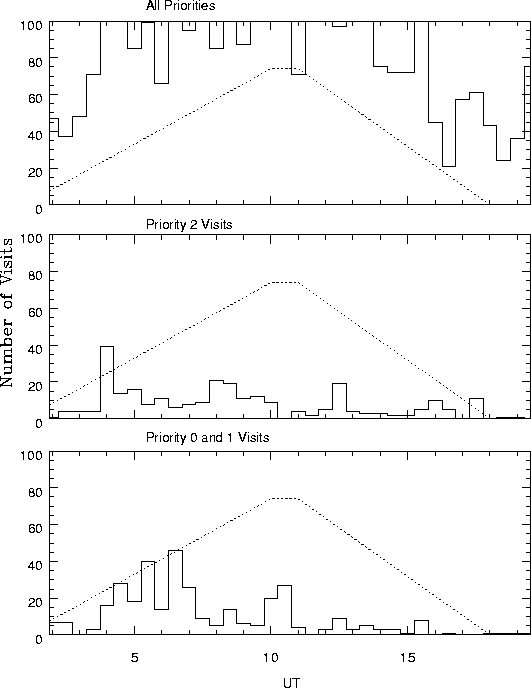
The following histogram shows some of the extrema in observing conditions: good seeing dark time, bright time and bad seeing dark time. A line has been drawn at the expected number of hour long visits that we hope to achieve in each hour bin.
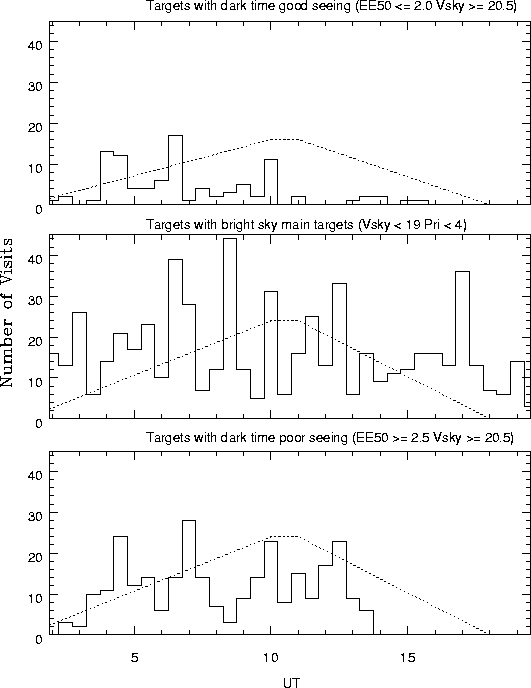
The following histogram shows the bright time priority 0-3 contribution from each partner. The dashed line is a rough estimate of the number of hour long visits one could complete during the remainder of the period.
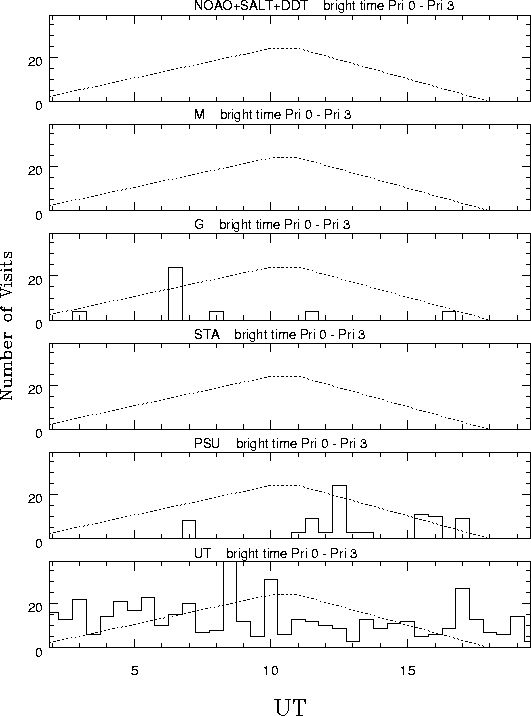
The following histogram shows the dark time priority 0-3 contribution from each partner. The dashed line is a rough estimate of the number of hour long visits one could complete during the remainder of the period.

From the above plots I have determined that: